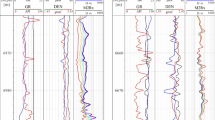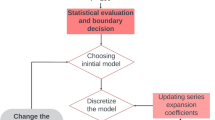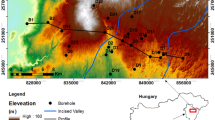Abstract
As part of the HRS-Geo technology, an interpretation system was created, which is based on the principles of continuous functional transformations along the well logging data for the study of borehole sections. The results of such transformations are necessary for optimal matching of the obtained physical parameters with the corresponding high-resolution seismic (HRS) ones. The features of the development and improvement of the methodology for processing and interpreting data from standard well logging methods according to the technique of integrating geophysical data by means of their functional transformations into information systems are considered. The results of logging data interpretation were obtained through the wide application of the well logs normalization method and their functional transformations, elimination of distortions in the original log curves, data integration when identifying complex reservoirs, assessing the porosity and density of various lithologies rocks, finding factors affecting geophysical parameters, determining influence bound water on resistivity in assessing the saturation of clay reservoirs and the effect of fluid composition on readings of normalized porosity and elastic wave velocity curves. The physical essence and principles of the normalized diagrams interpretation lie in the fact, with the help of the neutron gamma-ray logging curve, electrical resistivity variations caused by changes in the porosity of rocks along the section are excluded to consideration, and thereby areas of increased rock resistance due to their oil saturation are visually represented.
Access this chapter
Tax calculation will be finalised at checkout
Purchases are for personal use only
Similar content being viewed by others
References
Zalyayev, N. Z. (1990). Metodika avtomatizirovannoy interpretatsii geofizicheskikh issledovaniy skvazhin (Technique of automated interpretation of well logging) (p. 142). Minsk: University Edition.
Zalyayev, N. Z., Kaufman, R. M., & Mashara, L. P. (1978). Sistema obrabotki i shirokikh geofizicheskikh parametrov metoda funktsional'nykh preobrazovaniy (INGEF) (System of processing and integration of geophysical parameters by the method of functional transformations (INGEF)). V sb.: Problemy strukturnogo analiza v geofizike (Collection: Problems of structural analysis in geophysics) (pp. 100–112). Minsk: BelNIGRI.
Zalyayev, N. Z. (1981). Izucheniye razrezov slozhnogo litologicheskogo sostava po dannym geofizicheskikh issledovaniy v skvazhinakh (Study of complex lithological composition according to geophysical surveys in wells). Region., razved. i promysl. geofizika. VIEMS Review., M, p. 51.
Zalyayev, N. Z. (1981). Kompleksnaya interpretatsiya geofizicheskikh parametrov funktsional’nymi preobrazovaniyami s pomoshch'yu EVM (Complex interpretation of geophysical parameters by functional transformations with the help of a computer) (p. 150). Minsk: BelNIGRI.
Zalyayev, N. Z. (1984). Vliyaniye litologii i plastovykh uglevodorodov na geofizicheskiye parametry (Influence of lithology and reservoir hydrocarbons on geophysical parameters). Book: Metodika i rezul’taty geologo-geofizicheskikh issledovaniy v Pripyatskom progibe (Methodology and results of geological and geophysical research in the Pripyat Trough) (pp. 61–74). Minsk. Science and Technology.
Zalyayev, N. Z., Kaufman, R. M., & Mashara, L. P. (1981). O funktsiyakh, ispol’zuyemykh pri obrabotke promyslovo-geofizicheskikh materialov metodom funktsional’nykh preobrazovaniy (Sistema INGEF) (On the functions used in the processing of field geophysical materials by the method of functional transformations (INGEF System)). V sb.: Metody geofizicheskikh issledovaniy skvazhin (Collection: Methods of geophysical research of wells) (pp. 16–24). Minsk: BelNIGRI.
Debrand, R. (1972). Teoriya i interpretatsiya rezul'tatov geofizicheskikh metodov issledovaniy skvazhin (Theory and interpretation of the results of geophysical methods of well research) (p. 288). M., Nedra.
Dakhnov, V. N. (1985). Geofizicheskiye metody opredeleniya kollektorskikh svoystv i neftegazonasyshcheniya gornykh porod (Geophysical methods for determining reservoir properties) (p. 310). M., Nedra.
Vendel’shteyn, B. Yu., & Rezvanov, R. A. (1978). Geofizicheskiye metody opredeleniya parametrov neftegazovykh kollektorov (pri podschete zapasov i proyektirovanii razrabotki mestorozhdeniy) (Geophysical methods for determining the parameters of oil and gas reservoirs (when calculating reserves and designing field development)) (p. 318). M., Nedra.
Itenberg, S. S., & Shnurman, G. A. (1984). Interpretatsiya rezul’tatov karotazha slozhnykh kollektorov (Interpretation of logging results for complex reservoirs) (p. 256). M., Nedra.
Sokhranov, N. N., Aksel’rod, S. M., Zundelevich, I. M., & Churinova, I. M. (1989). Obrabotka i interpretatsiya dannykh promyslovykh geofizicheskikh issledovaniy na EVM (Processing and interpretation of field geophysical research data on a computer) (p. 240). Spravochnik/Pod red. Sokhranova N.N. / (Handbook: edited by Sokhranov N.N.). M., Nedra.
Ivakin, B. N., Karus, Ye. V., Kuznetsov, O. L. (1978). Akusticheskiy metod issledovaniya skvazhin (Acoustic method of well research) (p. 320). M., Nedra.
Masyukov, V. V., & Kaufman, R. M. (1981). Avtomatizirovannaya interpretatsiya karotazha skvazhin v Pripyatskom progibe (Automated interpretation of well logging in the Pripyat trough). V sb.: Metody geofizicheskikh issledovaniy skvazhin (Collection: Methods of geophysical research of wells) (pp. 3–16). Minsk: BelNIGRI.
Zalyayev, N. Z., Kaufman, R. M., Mashara, L. P. (1982). Kompleksnaya interpretatsiya dannykh karotazha v peschano-glinistykh razrezakh (Integrated interpretation of logging data in sandy-clay sections). V sb.: Metodika i rezul’taty interpretatsii karotazha neftyanykh skvazhin (Collection: Methodology and results of oil well logging interpretation) (pp. 16–25). Minsk: BelNIGRI.
Kaufman, R. M. (1982). Issledovaniye ustoychivosti resheniya zadachi opredeleniya kollektorskikh svoystv porod razreza po programme INGEF (Investigation of the solution stability of the problem for determining the rocks reservoir properties according to the INGEF program). V sb.: Metodika i rezul’taty interpretatsii karotazha neftyanykh skvazhin (pp. 25–30). Minsk: BelNIGRI (Collection: Methodology and results of oil well logging interpretation).
Zalyayev, N. Z., Kaufman, R. M., Mashara, L. P., Astapenko, V. A., & Gabrielyan, E. Kh. (1982). Printsipy postroyeniya i organizatsii sistemy obrabotki rezul’tatov tsifrovoy zapisi karotazha (Principles of construction and organization of a system for processing the results of digital logging recording). V sb.: Metodika i rezul’taty interpretatsii karotazha neftyanykh skvazhin (Collection: Methodology and results of oil well logging interpretation) (pp. 53–57). Minsk: BelNIGRI.
Zalyayev, N. Z., & Masyukov, V. V. (1970). Otsenka neftenosnosti karbonatnykh otlozheniy Pripyatskoy vpadiny po promyslovo-geofizicheskim dannym (Oil-bearing capacity estimation of the Pripyat depression carbonate deposits according to field geophysical data). V kn.: Geofizicheskiye metody poiskov i razvedki nefti i gaza v Pripyatskoy vpadine (Collection: Geophysical methods of prospecting and exploration of oil and gas in the Pripyat depression) (pp. 80–91). Minsk: Izd. Nauka i tekhnika (Ed. Science and Technology).
Basin, Ya. N., Berman, L. B., & Neyman, V. S. (1964). O vozmozhnosti vydeleniya kavernoznykh i treshchinovatykh izvestnyakov metodami promyslovoy geofiziki (On the possibility of separating cavernous and fractured limestones using field geophysics methods). Prikl. geofizika, vyp. 39 (Appl. geophysics, Vol. 39). M., Nedra.
Zalyayev, N. Z., Masyukov, V. V., & Orlov L. I. (1974). Opredeleniye neftenasyshchennosti karbonatnykh kollektorov po dannym promyslovoy geofiziki (Determination of oil saturation in carbonate reservoirs according to field geophysics data). V sb.: Pripyatskaya vpadina. Geologicheskiye rezul’taty, metodika i tsifrovaya obrabotka geofizicheskikh issledovaniy (Collection: Pripyat depression. Geological results, methodology and digital processing of geophysical surveys) (pp. 157–163). Minsk: BelNIGRI.
Zalyayev, N. Z. (1970). Opredeleniye poristosti i neftenasyshchennosti karbonatnykh porod po dannym elektricheskogo i radioaktivnogo karotazha (Determination of porosity and oil saturation of carbonate rocks according to electrical and radioactive logging data). V kn.: Geofizicheskiye metody poiskov i razvedki nefti i gaza v Pripyatskoy vpadine (Collection: Geophysical methods of prospecting and exploration for oil and gas in the Pripyat depression) (pp. 92–97). Izd. Nauka i tekhnika (Ed. Science and Technology).
Masyukov, V. V., & Kuznyanyy, V. A. i dr. (1971). Metodicheskiye rekomendatsii po provedeniyu geofizicheskikh issledovaniy skvazhin Pripyatskogo progiba i interpretatsii poluchennykh rezul’tataov (Methodological recommendations for conducting geophysical surveys of wells of the Pripyat trough and interpretation of the results obtained). Minsk: Izd. Nauka i tekhnika (Ed. Science and Technology).
Zalyayev, N. Z. (1974). Otsenka effektivnoy poristosti glinistykh porod sposobom normalizatsii diagramm radioaktivnogo karotazha (Evaluation of the clay rocks effective porosity by the method of radioactive logging diagrams normalization). V sb.: Pripyatskaya vpadina. Geologicheskiye rezul’taty, metodika i tsifrovaya obrabotka geofizicheskikh issledovaniy (Collection: Pripyat Depression. Geological results, methodology and digital processing of geophysical surveys) (pp. 216–220). Minsk: BelNIGRI.
Larionov, V. V. (1969). Radiometriya skvazhin (Well radiometry). M., Nedra.
Malinin, V. F., & Ruchkin, A. V. (1967). Ispol’zovaniye dannykh gamma-karotazha dlya litologicheskogo raschleneniya otlozheniy devona v vostochnoy chasti Pripyatskoy vpadiny (Use of gamma-ray data for lithological dissection of Devonian deposits in the eastern part of the Pripyat depression). V kn.: Metodika i geologicheskiye rezul’taty geofizicheskikh issledovaniy Pripyatskoy vpadiny (In the book: Methodology and geological results of geophysical studies of the Pripyat depression), Minsk, Nauka i tekhnika (Science and Technology).
Varlamov, A. S., & Filatov, V. G. (1983). Opredeleniye plotnosti gornykh porod i geologicheskikh ob"yektov (Determination of the density of rocks and geological objects) (p. 216). M., Nedra.
Zalyayev, N. Z., & Bondarenko, B. V. (1977). Algoritm opredeleniya plotnosti porod kompleksu geofizicheskikh issledovaniy skvazhin (Algorithm for determining the density of rocks for a complex of geophysical well surveys). V sb.: Pripyatskaya vpadina. Izucheniye slozhnopostroyennykh struktur geofizicheskimi metodami (Collection: Pripyat Depression. The study of complex structures by geophysical methods) (pp. 156–161). Minsk: BelNIGRI.
Zalyayev, N. Z., Kaufman, R. M., & Mashara, L. P. (1985). Vydeleniye polimiktovykh peschanikov po dannym standartnogo karotazha (programma TerINGEF) (Identification of polymictic sandstones according to standard logging data (TerINGEF program)). V sb.: Interpretatsiya materialov karotazha v slozhnykh razrezakh nefteperspektivnykh tolshch (Collection: Interpretation of logging data in complex sections of oil-promising strata) (pp. 13–21). Minsk: BelNIGRI.
Zalyayev, N. Z., Mogilevich, M. V., & Astapenko, V. A. (1984). Izucheniye fizicheskikh svoystv porod terrigennogo razreza po materialam karotazha skvazhin (Physical properties study of the terrigenous rocks based on well logging data). V sb.: Interpretatsiya materialov karotazha v slozhnykh razrezakh nefteperspektivnykh tolshch (Collection: Interpretation of logging data in complex sections of oil-promising strata) (pp. 40–49). Minsk: BelNIGRI.
Zalyayev, N. Z. (1984). Vliyaniye litologii i plastovykh uglevodorodov ne geofizicheskiye parametry (The influence of lithology and reservoir hydrocarbons are not geophysical parameters). V kn.: Metodika i rezul’taty geologo-geofizicheskikh neftepoiskovykh issledovaniy v Pripyatskom progibe (Collection: Methodology and results of geological and geophysical oil exploration in the Pripyat trough) (pp. 61–74). Minsk: Izd. Nauka i tekhnika.
Ellanskiy, M. M. (1978). Petrofizicheskiye svyazi i kompleksnaya interpretatsiya dannykh promyslovoy geofiziki (Petrophysical relations and complex interpretation of production geophysics data) (p. 215). M., Nedra.
Ellanskiy, M. M., & Yenikeyev, B. N. (1991). Ispol’zovaniye mnogomernykh svyazey v neftegazovoy geologii (The use of multidimensional relationships in oil and gas geology) (p. 205). M., Nedra.
Bulatova, M. M., Volkova, Ye. A., & Dubov, Ye. F. (1970). Akusticheskiy karotazh (Acoustic logging) (L., p. 264).
Zalyayev, N. Z., Kononov, A. I., & Drobysheva, V. G. (1985). Otsenka paleotermobaricheskikh usloviy po rezul’tatam GIS. Geologiya nefti i gaza (Evaluation of paleothermobaric conditions based on logging results) (№ 8, p. 13).
Vendel’shteyn, B. Yu. (1966). Issledovaniye razrezov neftyanykh i gazovykh skvazhin metodom sobstvennykh potentsialov (Investigation of oil and gas wells sections by the method of self-potentials) (p. 206). M., Nedra.
Vendel’shteyn, B. Yu. (1962). Ob uchete glinistosti pri opredelenii poristosti po dannym metoda soprotivleniy (On accounting for clay content in determining porosity using the data of the resistance method). Prikladnaya geofizika. Vyp. 32 (Applied geophysics. Issue. 32), M., p. 8.
Kaufman, R. M., & Mashara, L. P. (1985). Sposoby opredeleniya soderzhaniya svyazannoy vody v porodakh po programmam INGEF (Methods for determining the content of bound water in rocks according to the INGEF programs). V sb.: Interpretatsiya materialov karotazha v slozhnykh razrezakh nefteperspektivnykh tolshch (Collection: Interpretation of logging data in complex sections of oil-promising strata) (pp. 58–66). Minsk: BelNIGRI.
Zalyayev, N. Z., & Masyukov, V. V. (1985). Problemy vydeleniya i otsenki peschanykh kollektorov slozhnogo sostava v mezhsolevykh otlozheniyakh po karotazhu i puti povysheniya effektivnosti promyslovo-geofizicheskikh issledovaniy (Problems of identifying and evaluating sandy reservoirs of complex composition in intersalt deposits by logging and ways to improve the efficiency of field geophysical surveys). V sb.: Tipy zalezhey nefti Pripyatskogo progiba i ikh prognoz (Collection: Types of oil deposits in the Pripyat trough and their prediction) (pp. 142–155). Minsk: BelNIGRI.
Masyukov, V. V., & Zalyayev, N. Z. (1989). Vyyavleniye bituminoznosti glinistykh obrazovaniy po materialam karotazha skvazhin (Collection: Peculiarities of formation and placement of oil deposits in the Pripyat trough). V sb.: Osobennosti formirovaniya i razmeshcheniya zalezhey nefti v Pripyatskom progibe (pp. 110–116). Minsk: BelNIGRI.
Zalyayev, N. Z. (1989). Rol’ svyazannoy vody v formirovanii zalezhey nefti (The role of bound water in the formation of oil deposits). V sb.: Osobennosti formirovaniya i razmeshcheniya zalezhey nefti v Pripyatskom progibe (Collection: “Peculiarities of formation and placement of oil deposits in the Pripyat trough”) (pp. 117–128). Minsk: BelNIGRI.
Trofimov, V. L., Khaziyev, F. F., & Trofimova, A. V. (2019). Tekhnologiya vysokorazreshayushchey seysmiki pri poiskakh i razvedke neftegazovykh zalezhey (High-resolution seismic technology in prospecting and exploration of oil and gas deposits) (p. 343). M., EAGE Geomodel LLC.
Trofimov, V. L., Khaziev, F. F, & Trofimova A. V. (2022). Oil and gas reservoir prospecting and exploration. High-Resolution Seismic (HRS) techniques and technology. Springer (Hardcover Book, eBook). https://doi.org/10.1007/978-3-030-84389-2
Geofizicheskiye metody issledovaniya skvazhin. (2022). (Geophysical methods of well research). https://studwood.net/1919624/matematika_himiya_fizika/geofizicheskie_metody_issledovaniya_neftyanyh_i_gazovyh_skvazhin
Author information
Authors and Affiliations
Rights and permissions
Copyright information
© 2023 The Author(s), under exclusive license to Springer Nature Switzerland AG
About this chapter
Cite this chapter
Trofimov, V.L., Khaziev, F.F., Trofimova, A.V. (2023). Wells Data Geophysical Research Interpretation Features. In: Theory and Practice of High Resolution Seismic HRS-Geo Technology Application. Springer, Cham. https://doi.org/10.1007/978-3-031-41590-6_4
Download citation
DOI: https://doi.org/10.1007/978-3-031-41590-6_4
Published:
Publisher Name: Springer, Cham
Print ISBN: 978-3-031-41589-0
Online ISBN: 978-3-031-41590-6
eBook Packages: Earth and Environmental ScienceEarth and Environmental Science (R0)




